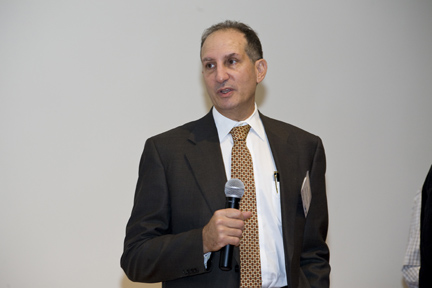Wired hospitals in need of critical care
 |
| Symposium presenter Marc Bloom of NYU's Langone Medical Center: “We’re working in a World War II infrastructure." |
“I’ve seen a tethered wire pull down an I.V. stand into a sterile field,” says Marc Bloom, Director of Perioperative Technology in the Department of Anesthesiology at New York University’s Langone Medical Center.
While sobering, that’s a mild example of the potential dangers advanced medical equipment has introduced to operating rooms and other hospital environments. Take for example the potentially fatal hazard of monitoring and life-sustaining equipment connected to each other, power sources, and Ethernet ports with non-medical plugs. Yes, the plugs that so easily pop out with an accidental kick under your desk are the very same ones used in many operating rooms.
Tethered wires and unsecure plugs are just the beginning of the messy picture painted of today’s wired hospital health care at “Malignant Spaghetti,” a day-long symposium Polytechnic Institute of NYU hosted on November 14.
Experts from academia, industry, government, hospitals, and medical schools attended the symposium to explore existing and future wireless hospital technologies. Ivan Selesnick and Elza Erkip, both of NYU-Poly’s Department of Electrical and Computer Engineering, co-chaired the event.
A “World War II infrastructure”
Dr. Bloom first uttered the phrase “malignant spaghetti” a number of years ago while describing the feeling – as much metaphorical as physical – of being entangled by an operating room’s mass of wires.
The problem, according to Dr. Bloom, is that new technologies, with their monitors, cumbersome hardware, and feet upon feet of cables and wires, are being used in operating rooms and other hospital environments that simply weren’t designed for them. “We’re working in a World War II infrastructure,” he said.
Symposium presenter Julian M. Goldman, Director of Massachusetts General Hospital’s Medical Device “Plug and Play” Interoperability Program, illustrated the ad hoc approach many hospitals have taken to adopting new medical equipment. He juxtaposed an image of a typical operating room in America with an image of a U.S. military operating room in Iraq. Neither lacked for malignant spaghetti.
Machines should “talk” to each other
Poor interconnectivity also ails contemporary operating rooms. When a radiologist takes a mid-surgery image of a patient, the patient needs to be disconnected from the ventilator. If things go as they should – and most of the time they do – the patient is swiftly reconnected to the ventilator when the radiologist is finished.
But what happens if things don’t go as planned and someone in the busy, overcrowded operating room forgets to reconnect the patient? Because the X-ray machine and ventilator don’t “talk” to each other, there’s no safeguard against tragedy-inducing human error. A better scenario, one that Dr. Bloom presented as achievable, is to implement “smart interconnectivity” in which X-ray machines, ventilators, infusion pumps, vital sign monitors, and the like, communicate with each other – and in the ideal scenario, wirelessly so.
Synching up machines is more than a technical matter. As Dr. Bloom noted, there’s currently a lack of standards that make for disparate data. “That’s why we invited manufacturers to participate [in the symposium],” he said. “We still need to develop protocols for communication.”
Untangling hospital health care
The wireless technology that pervades our everyday life can make the lack of similar technologies in hospitals difficult to understand. Consider applications on smartphones that allow people to take pictures of barcodes and instantly comparison shop online. Why is such technology seemingly so easily applied to mundane activities, and not to the critical activities of hospitals in the operating room and beyond, like tracking medications given to patients, or sending patients’ vital signs to handheld devices so they can be monitored from anywhere in the hospital?
As NYU-Poly Associate Provost Kurt Becker explained, “wireless technologies have made an enormous contribution in many fields and they can play a key role in advancing health care applications, but what is technologically feasible is not always accepted by the end user for a variety of reasons. Oddly enough, hospitals are not among the institutions that embrace technological innovation easily. The issue of wireless technologies in hospital health care is complex and multi-faceted.” This was a key reason for the symposium. “We wanted to define problem areas, identify needs and challenges, and explore opportunities and umbrella issues,” said Dr. Becker.
Dr. Becker said that no surveys exist to determine the full impact that wireless technologies can have in hospitals in terms of patient care. “Metrics have not been developed,” he said, but he remains convinced that wireless technologies results in improved patient care at a lower cost.
Signs of the future
Stan Zwierzchowski of the University of Calgary presented a promising example of where wireless technologies are headed: a “smart bandage” that wirelessly transmits a patient’s core temperature, an important vital sign. The “smart bandage” is currently in clinical trials.
And in Boston, doctors, nurses, researchers, and engineers are already at work in “the operating room of the future.” Dr. Goldman gave an overview of the operating room built by the Center for Integration of Medicine and Innovative Technology. He described it as “a living laboratory” where a team of researchers is studying best design and procedural practices for a truly smart, 21st century operating room.
Much of “the operating room of the future’s” equipment was built or customized in-house because it doesn’t exist commercially — a point that gave significant subtext to the Malignant Spaghetti symposium: the opportunities for manufactures, engineers, research institutions, and investors to make “the operating room of the future” a reality for America’s — and the world’s — thousands of hospitals is huge.




